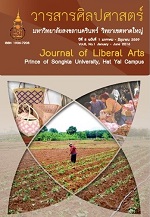Community practices for disaster risk reduction: A case of flash flood and landslide risk areas in Nakhon Si Thammarat
Keywords:
community network, disaster, risk reduction, flash flood and landslideAbstract
This research aimed to examine community practices to reduce risk from flash flood and landslide disasters. Qualitative research method was applied, and data were collected from related documents, a group interview and in-depth interviews with a group of informants in the community consisting of villagers, monk, volunteers of the community network, and community leaders in the risk areas in Ban Thap Nam Tao, Mu 8, Krung Ching Sub-district, Nopphitam District, Nakhon Si Thammarat that were faced with lash floods and landslides in April, 2010. Content analysis was conducted with the data obtained.
The finding showed that the community practices in preparation for reducing the risk of flash floods and landslides are in two levels: 1) operating through a network of surveillance and disaster victims. This is a network of a sub-district level that would raise awareness about the needs to have a network. A communication system and mechanisms have been developed to connect with outsiders, and 2) operating through the community network to share responsibility of caring for the community. The community network has surveyed all households in each vulnerable area and has provided guidelines for disaster risk reduction. Moreover, the network prepared life-saving equipment, shelters, disaster drills, improvement of the community areas to reduce water barriers and site preparation for building a temporary bridge to outside in an event of flashflood disasters, and the network has advised locals to plant vegetables for food.
Downloads
Published
How to Cite
Issue
Section
License
Copyright (c) 2016 วารสารศิลปศาสตร์ มหาวิทยาลัยสงขลานครินทร์ วิทยาเขตหาดใหญ่ (Journal of Liberal Arts Prince of Songkla University Hat Yai)

This work is licensed under a Creative Commons Attribution-NonCommercial-NoDerivatives 4.0 International License.
The authors retain the copyright to their article but the Journal of Liberal Arts, Prince of Songkla University reserves the exclusive rights to first publication.






